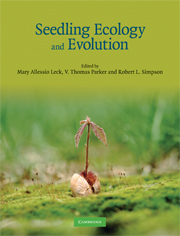Book contents
- Frontmatter
- Contents
- Contributors
- Foreword by Peter J. Grubb
- Preface
- Acknowledgments
- Part I Introduction
- Part II Seedling diversity
- Part III Seedling morphology, evolution, and physiology
- Chapter 5 Embryo morphology and seedling evolution
- Chapter 6 Regeneration ecology of early angiosperm seeds and seedlings: integrating inferences from extant basal lineages and fossils
- Chapter 7 Physiological and morphological changes during early seedling growth: roles of phytohormones
- Chapter 8 Seedling ecophysiology: strategies toward achievement of positive net carbon balance
- Chapter 9 The role of symbioses in seedling establishment and survival
- Part IV Life history implications
- Part V Applications
- Part VI Synthesis
- References
- Index
Chapter 7 - Physiological and morphological changes during early seedling growth: roles of phytohormones
Published online by Cambridge University Press: 05 June 2012
- Frontmatter
- Contents
- Contributors
- Foreword by Peter J. Grubb
- Preface
- Acknowledgments
- Part I Introduction
- Part II Seedling diversity
- Part III Seedling morphology, evolution, and physiology
- Chapter 5 Embryo morphology and seedling evolution
- Chapter 6 Regeneration ecology of early angiosperm seeds and seedlings: integrating inferences from extant basal lineages and fossils
- Chapter 7 Physiological and morphological changes during early seedling growth: roles of phytohormones
- Chapter 8 Seedling ecophysiology: strategies toward achievement of positive net carbon balance
- Chapter 9 The role of symbioses in seedling establishment and survival
- Part IV Life history implications
- Part V Applications
- Part VI Synthesis
- References
- Index
Summary
Introduction: Phytohormones, molecular biology, and the “real world” of early seedling ecology
The seedling stage is arguably the busiest phase in a plant's lifetime. A miniscule individual, possessing only a rudimentary cotyledon and radicle, must quickly make its way in the world before a host of environmental challenges and larger competitors bully it out of existence. The maternal reserves from the seed must be mobilized to provide the fuel for producing the first pair of photosynthetically competent leaves and proliferating roots that will assimilate nutrients and firmly secure the seedling to its new home in the soil. These critical activities are initiated within minutes of germination, requiring a flurry of rapid signal transduction, protein synthesis, and tissue differentiation. To grasp how the seedling accomplishes all this demands an examination of physiological mechanisms that govern life after germination.
Studies at the molecular level are making great headway in understanding the complex and fascinating physiological events that mark the early infancy of plants. Phytohormones (a broad term that encompasses a range of organic and polypeptide compounds) are increasingly recognized as the primary integrators of environmental signals that enable the nascent seedling to evaluate and adjust to existing conditions. Biologists working across the spectrum of organizational levels – from cells to trees, from genes to populations – are now in an exciting position to elucidate how phytohormones modulate phenotype, and seedlings from a variety of taxa are natural model systems for study and synthesis (Table 7.1).
- Type
- Chapter
- Information
- Seedling Ecology and Evolution , pp. 150 - 171Publisher: Cambridge University PressPrint publication year: 2008
- 4
- Cited by



